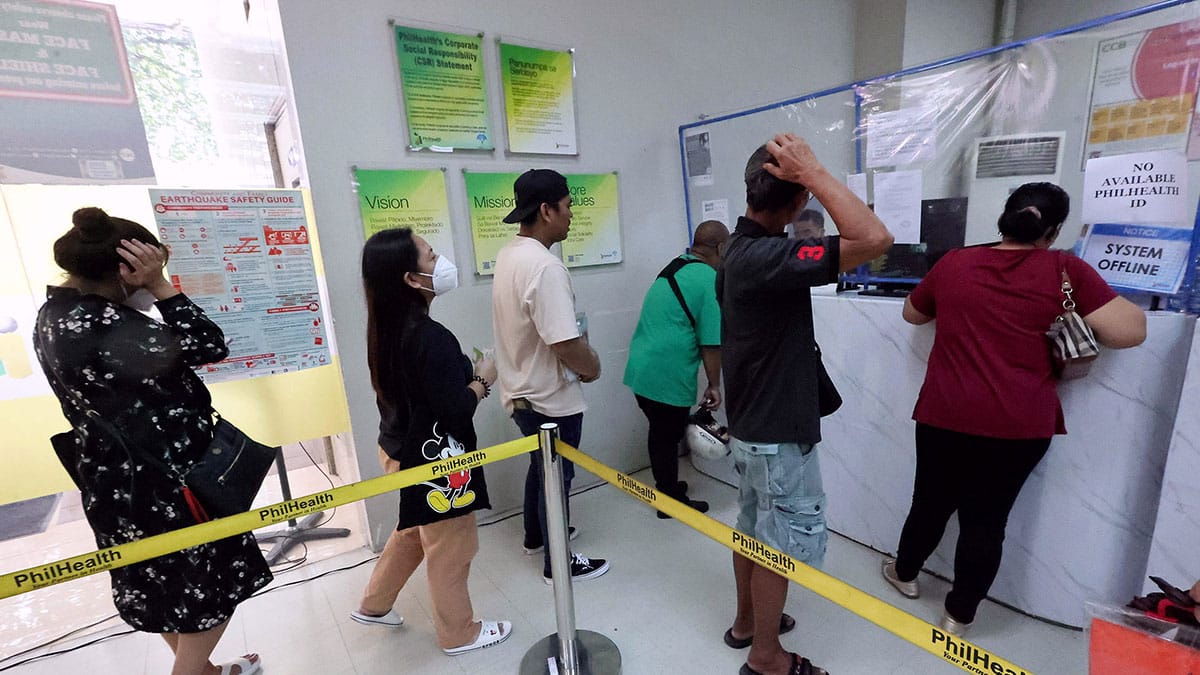COA: 4,000 dead seniors still on PhilHealth database

QUEUE FOR BENEFITS Members of the Philippine Health Insurance Corp. (PhilHealth) visit the state insurer’s office in Quezon City, shown in this 2023 photo, to inquire about their benefits. —Grig C. Montegrande
MANILA, Philippines — Thousands of deceased senior citizens remain in the database of the Philippine Health Insurance Corp. (PhilHealth), while data on more than a million others were either incomplete or erroneous, according to the Commission on Audit (COA).
State auditors flagged the PhilHealth program for its enrolled senior citizens, which they said had a deficiency when it comes to collection and management process controls of the data on its 8.5 million enrollees.
According to the COA’s annual audit report on the state health insurer, this deficiency resulted in several issues, including the incomplete and erroneous entries for 1.3 million beneficiaries, duplication of nearly 270,000 senior citizen members and the inclusion of 4,062 deceased members in the PhilHealth Members Database (PMD) and billings to the Department of Budget and Management (DBM).
The COA said its audit team sent letters to 250 health-care institutions (HCIs) requesting the list of its deceased patients as of Dec. 31, 2022.
Of the HCIs contacted, 63 responded, revealing that 3,616 senior citizens tagged as deceased from 2019 to 2022 were still included in the PMD.
Article continues after this advertisement“It is emphasized that the 63 respondents (HCIs) represent only 3.41 percent of PhilHealth’s total 1,846 accredited hospitals as of July 31, 2023. Thus, the aggregate number of deceased SC (senior citizens) in the database can be [much higher],” it added.
Article continues after this advertisementAnother issue raised by the COA was that the elderly members’ data showed that 1.3 million enrolled beneficiaries, or 15.55 percent of the total, either have incomplete or erroneous details.
Most of the errors found by the COA pertained to the encoding of only a beneficiary’s middle initial instead of the full middle name, which involved 1.25 million beneficiaries.
Other errors included entries with no middle name, misspelled names, no encoding of their first or second names, and even suffixes that were not encoded in the right field.
The COA also raised the duplication and multiple entries for 266,665 enrolled senior citizens.
Assuming that half of them “are the unique or original data, the estimated minimum overbilling made by PhilHealth to the [national government] at P5,000 per member would be P666.66 million,” the report said.
Enough funds
On PhilHealth’s zero subsidy in 2025, President Marcos on Monday allayed concerns over its impact on the state insurer’s operations, agreeing that it has ample funds to sustain health services mandated by Republic Act No. 11223 or the Universal Health Care Act.
“PhilHealth can pay for all its services, and the reason we do not want to subsidize it is because the subsidy will only sit in PhilHealth’s bank account and will remain unused,” he said.
Marcos made the justification to respond to the public uproar whipped up by the zero subsidy for PhilHealth next year.
“PhilHealth has P500 billion reserved and to provide their services in one year is less than P100 billion [and] their budget… for expenditures is about P260 billion, so they will still have reserves,” he noted.
“In other words, PhilHealth has sufficient budget to do all of the things that they want to do,” Mr. Marcos said.
Health Secretary Teodoro Herbosa, who chairs the PhilHealth board, on Monday also assured the public that the state insurer has P150 billion in surplus funds, or more than enough to pay for the contribution of its nonpaying members.
“Critics are wrong that PhilHealth has no budget next year. It has a big budget of P284 billion approved by the PhilHealth board,” he said.
Of this, P271 billion is allotted for benefit expenses, P12 billion for administrative expenses, and the rest for capital outlay.
Herbosa added that of PhilHealth’s P244-billion budget for benefit expenses this year, only 63 percent has been used as of the end of October.
The balance of P90 billion plus the P61 billion allotted for PhilHealth under the proposed 2025 budget could be used to pay for the P80 billion in premium payments of its 16 million Filipino “indirect contributors”—senior citizens, persons with disability, indigents, 4Ps beneficiaries, and those without the capacity to pay. —with reports from Melvin Gascon, Dexter Cabalza, and INQUIRER.net